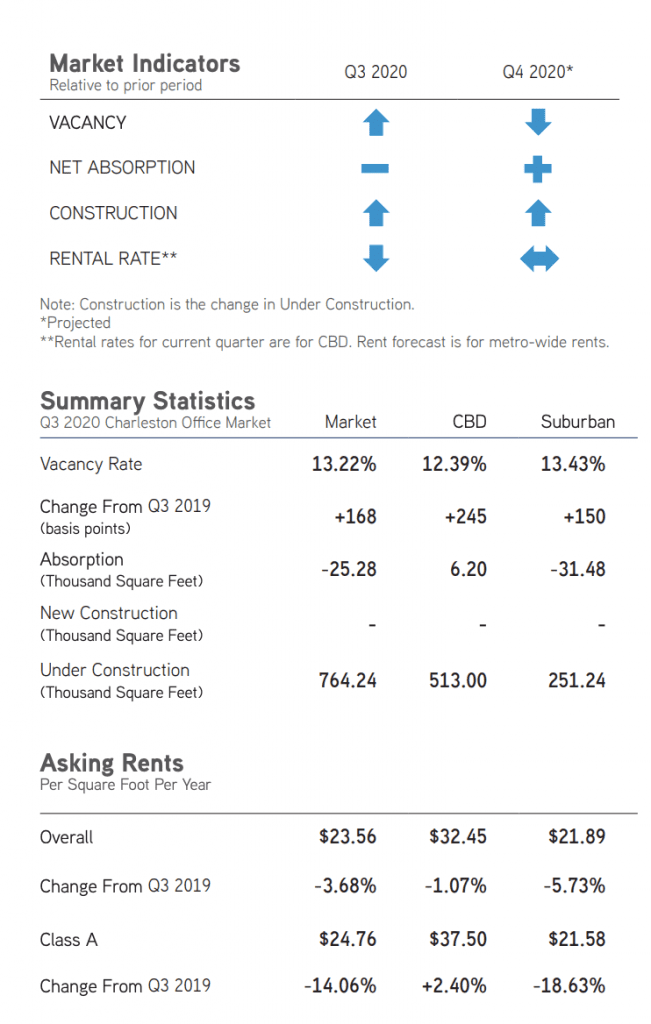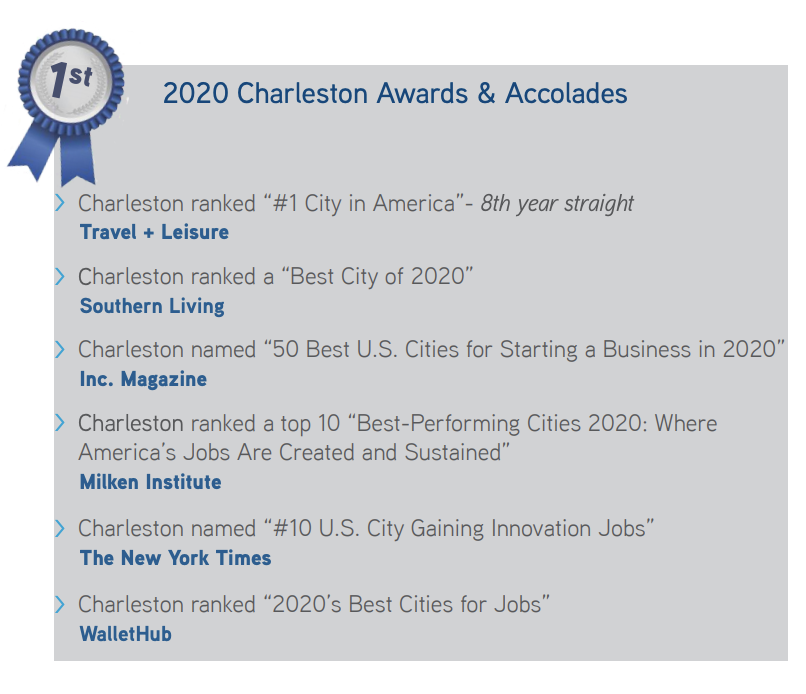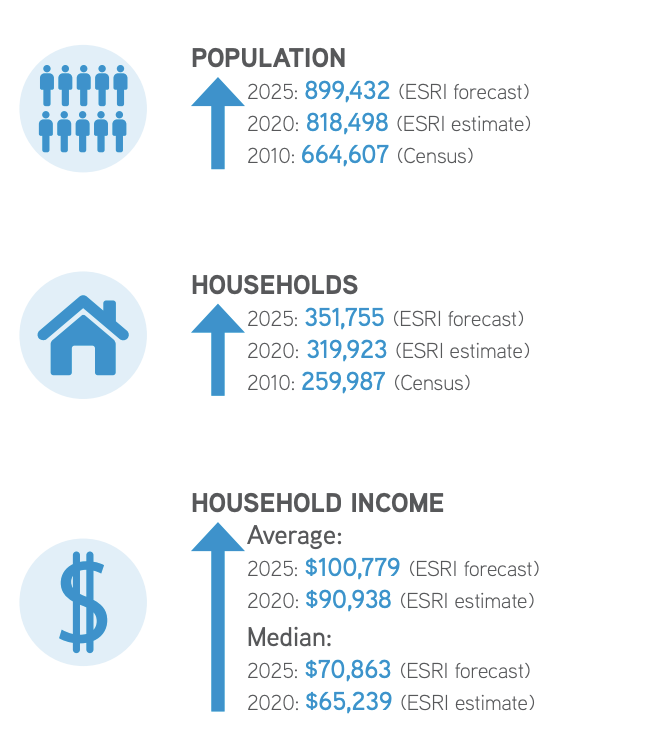Colliers Report: Charleston is prime for population spike, eventually increasing demand
September 30, 2020Key Takeaways
- Negative effects of the pandemic are starting to be evident in the Charleston office market – no new offices were delivered; however, the office market posted a negative overall absorption of 25,280 square feet.
- Overall Charleston office rental rates are lower this quarter, except in Class A central business district office space. The drop in rental rates may be partly a result of owners lowering rates to lease space quickly to accommodate for tenants downsizing or moving due to the Coronavirus.
- Following the pandemic, cities with less population density, such as Charleston, are becoming more attractive.
Charleston draws new residents
 Charleston has received many accolades over the years regarding its quality of life and dynamic business environment, making it a favorite relocation choice for people from all over the nation. Residents moving from other states made South Carolina the 6th fastest growing state last year. In addition, Charleston’s regional population is growing three times faster than the United States average.
Charleston has received many accolades over the years regarding its quality of life and dynamic business environment, making it a favorite relocation choice for people from all over the nation. Residents moving from other states made South Carolina the 6th fastest growing state last year. In addition, Charleston’s regional population is growing three times faster than the United States average.
There are several reasons the region continues to be popular. Charleston is home to multiple public and private universities, as well as technical college systems, collectively offering training and education programs that support the growing regional labor force. Also, desirable housing and a strong job market are a large draw for new Charleston residents. Charleston’s livability factor is high due to world-renowned dining, a mild climate with beautiful beaches and a multitude of walkable historical landmarks and sites to visit. Charleston has drawn tourists to the area for several years; however, following the pandemic, cities with less population density are becoming even more attractive. Many people from larger northeastern U.S. cities are relocating to smaller southern cities such as Charleston. According to Zillow, the average time for a Charleston home to be on the housing market is only 100 days, meaning houses for sale are purchased often within a little over three months of being listed, showing how high the demand for housing is. Due to the draw of new residents and a need for space afforded within tertiary cities such as Charleston, a future population boom will likely increase the need for office space and absorb availabilities created as a result of the pandemic.
Market Overview
Overall Charleston Market
 The Charleston office market is comprised of approximately 14.26 million square feet and there are currently 12 office buildings under construction which, upon completion, will add 764,240 square feet to the office market. In addition, there are 14 proposed offices totaling 1.09 million square feet adding to the construction pipeline. No new offices were delivered to the Charleston office market however, the office market posted a negative overall absorption of 25,280 square feet during the third quarter of 2020. The effects of the pandemic are likely the cause of much of the negative absorption this quarter as some companies choose remote work setting or downsizing options. Lower North Charleston posted much of the positive activity, this submarket absorbed 41,247 square feet. The overall negative absorption forced the vacancy rate upward from 13.07% during the second quarter of 2020 to 13.22% this quarter. Charleston office market rental rates were marginally lower at $23.56 per square foot during the third quarter of this year. The drop in rental rates may be partly a result of owners trying to lease vacant space quickly to accommodate for tenants downsizing or moving as a result of the Coronavirus.
The Charleston office market is comprised of approximately 14.26 million square feet and there are currently 12 office buildings under construction which, upon completion, will add 764,240 square feet to the office market. In addition, there are 14 proposed offices totaling 1.09 million square feet adding to the construction pipeline. No new offices were delivered to the Charleston office market however, the office market posted a negative overall absorption of 25,280 square feet during the third quarter of 2020. The effects of the pandemic are likely the cause of much of the negative absorption this quarter as some companies choose remote work setting or downsizing options. Lower North Charleston posted much of the positive activity, this submarket absorbed 41,247 square feet. The overall negative absorption forced the vacancy rate upward from 13.07% during the second quarter of 2020 to 13.22% this quarter. Charleston office market rental rates were marginally lower at $23.56 per square foot during the third quarter of this year. The drop in rental rates may be partly a result of owners trying to lease vacant space quickly to accommodate for tenants downsizing or moving as a result of the Coronavirus.
Central Business District
 The central business district has 88 buildings totaling 2.91 million square feet in Charleston and there are currently 438,000 square feet of office buildings under construction. Charleston may be feeling tenant’s hesitancy to make a change during the pandemic; only 8 buildings in downtown Charleston posted activity this quarter. Offices in the Charleston central business district absorbed 6,201 square feet during the third quarter of 2020, almost half of which was in Class A office space. While this absorption was minimal, it dropped the vacancy rate slightly from 12.61% during the second quarter of 2020 to 12.39% this quarter. The average weighted rental rate during the third quarter of 2020 was $32.45 per square foot for the remaining downtown availabilities. Class A central business district rental rates are currently higher than they were this time last year, because there are higher quality spaces currently available.
The central business district has 88 buildings totaling 2.91 million square feet in Charleston and there are currently 438,000 square feet of office buildings under construction. Charleston may be feeling tenant’s hesitancy to make a change during the pandemic; only 8 buildings in downtown Charleston posted activity this quarter. Offices in the Charleston central business district absorbed 6,201 square feet during the third quarter of 2020, almost half of which was in Class A office space. While this absorption was minimal, it dropped the vacancy rate slightly from 12.61% during the second quarter of 2020 to 12.39% this quarter. The average weighted rental rate during the third quarter of 2020 was $32.45 per square foot for the remaining downtown availabilities. Class A central business district rental rates are currently higher than they were this time last year, because there are higher quality spaces currently available.
Suburban Conditions
The Charleston suburban office market is comprised of 11.35 million square feet and there are seven offices totaling 251,240 square feet under construction throughout the suburban submarkets. While there were several suburban office buildings which posted positive absorption during the third quarter of 2020, the overall negative absorption outweighed the positive. Charleston suburbs posted a negative 31,481 square feet this quarter, most of which was in Class B suburban space. Class A suburban offices absorbed 17,385 square feet. The suburban vacancy rate increased from 13.19% last quarter to 13.43% during the third quarter of this year. The overall suburban average weighted rental rate for the remaining availabilities decreased from $23.01 during the second quarter of 2020 to $21.89 per square foot during the third quarter of 2020.
Significant Transactions
According to Costar, there were 18 office sales within the Charleston market this quarter, the two largest were medical office buildings. In addition, there were 76 leases executed during the third quarter of 2020.
Office-Using Employment
Office-using employment covers jobs related to the professional and business services, financial activities and information sectors. According to the most recent data from the Bureau of Labor Statistics, the amount of office-using jobs is normalizing. In just three months, during the period from April 2020 through July 2020, the number of jobs lost in Charleston decreased from 8,449 to 4,451. This is a positive sign that employers are rehiring and reopening following the lifted quarantine restrictions. The Charleston-North Charleston-Summerville unemployment rate was 9.2% as of July 2020 and is expected to decline through year-end as more companies open for business.
Market Forecast
As the effects of the pandemic become evident with new vacancies in high quality space, more residents are also moving to southern regions. Therefore, while the vacancy rate may increase for the next couple of quarters, an influx of new residents will likely lease the currently vacant spaces. Rental rates are lower this quarter as landlords attempt to lease space quickly in order to fill their buildings. Central business district Class A rental rates have continued to climb because that space is high-quality and in demand. New construction deliveries are expected to raise the overall rental rates within a few quarters. The full affects of the pandemic are still playing out within the office market, so there are still uncertainties. Nevertheless, Charleston’s positive business environment and attraction of new residents should allow for future positive growth.
A Note Regarding COVID-19
As we publish this report, the U.S. and the world at large are facing a tremendous challenge, the scale of which is unprecedented in recent history. The spread of the novel coronavirus (COVID-19) is significantly altering day-to-day life, impacting society, the economy and, by extension, commercial real estate.
The extent, length and severity of this pandemic is unknown and continues to evolve at a rapid pace. The scale of the impact and its timing varies between locations. To better understand trends and emerging adjustments, please subscribe to Colliers’ COVID-19 Knowledge Leader page for resources and recent updates.
For additional commercial real estate news, check out our market reports here.













